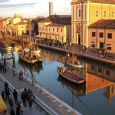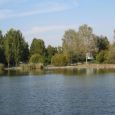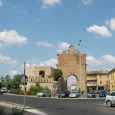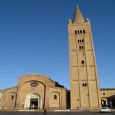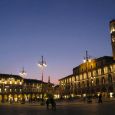Forli
Advertisement
By Air
Forli has its own airport located about 4 km from the city center, named after Luigi Ridolfi, who is second on the region and the twenty-fourth in Italy for passenger traffic, with a significant increase compared to the past.The other major international or intercontinental airport facilities closer to the city are: Rimini, Bologna Ducati (82 km), Florence-Peretola (177 km), Pisa, San Giusto (265 km), Milan-Malpensa (339 km) and Rome -Fiumicino (378 km).
By Train
Forli railway station forms part of the Bologna–Ancona railway.Opened in 1926, it replaced Forli's original station, which had been opened in 1861.The passenger building of the original station still stands, about 100 metres (or yards) west of the present station.
By Road
Forli is connected to the national motorway network via the namesake of the toll motorway A14 Bologna-Taranto.Altre important roads that touch the city are the SS 9 Via Emilia, which connects with all the capitals of the Emilia-Romagna, Ravenna and Ferrara, except more Lodi and Milan and the State Route 67 Tuscan Romagna, which connects with both the Tuscan cities of Florence and Pisa and the nearby Ravenna.
By Bus
The supervision of local transport services is provided by ATR Agency for Mobility (acronym for Transport Company Romagnoli), which includes the local lines, the countryman, pointing towards the suburban and suburban area of the province of Forli.
Piazza Saffi
is located at the heart of Forli, Italy and offers some of the most interesting town sights.It has a trapezoidal shape and is about 128 metres (420 ft) long and 87 metres (285 ft) wide.In the middle of the square there stands the statue of Aurelio Saffi which is surrounded by some of the most distinguished and ancient buildings of the town.On the southern side of the square there stands the Abbey of San Mercuriale.Next to the Abbey there is the Palazzo Paulucci de Calboli, built at the beginning of the 18th century.The eastern side of the square is taken up by the Palazzo delle Poste (Post Building), built in the early 1930s.The palazzo comunale takes up the northern side of the square.It dates back to the year 1000 and it is now the seat of the Town Hall.On the west side, at the corner with Corso Diaz, there stands the Palazzo del Podesta, built in gothic style in 1460.On its right side there is Palazzo Albertini, an elegant 15th-century building in Venetian style.
Merenda's Palace
The Palace of Ancient Snack or hospital is located in Forlì in the Course of the Republic.In the building housed the library "Saffi".It was built in 1722 with the project of the friar Dominican Giuseppe Merenda to accommodate the Hospital for Sick House of God.Between 1778 and 1783, the death of Merenda monumental staircase was built by Raymond Compagnoni.In 1827 however the new facade was built by Giuseppe Pani.The complex of buildings with "Exposed" for the orphans and hydrotherapy was enlarged and completed in 1848 by engineer Joseph cantons.The building was used as a hospital until the opening of the new hospital Giovan Battista Morgagni in 1922 after building snack.Snack Palace will be incorporated in the new campus, which is due to open in March 2013 in the former hospital, "GB Morgagni", and will be the natural filter between the city and the university, hosting the library "Saffi" and student clubs.
Palace Hercolani
Until 1844 the Palazzo belonged to the ancient family Hercolani Hercolani of Forli, whose members include Hercolani Caesar, the "winner of Pavia." The last heir, Fabrizio Hercolani Gaddi, son of Cesarina Hercolani and Lepidus Hercolani Gaddi, sold the property in 1844 to Count Sixth Matteucci, who undertook a number of renovations of the building while leaving the plan unchanged.The palace had been the result amalgamation of three different buildings and the Sixth Count Matteucci gave the structure a more qualified to meet your needs for comfort and decoration making uniform the three separate buildings.In 1866 the palace became the property of the family when Guarini Matteucci Victoria married Filippo Guarini.In 1946 the building was sold by the Countess Maria Acquaderni, widow Guarini cooperative society to Karl Marx.
Monumental Cemetery of Forli
which is one of the most remarkable architecture of the cemetery Romagna, begins to emerge, as early as 1807, at present, following the promulgation of the Edict of Saint-Cloud ( 1804 ) by Napoleon Bonaparte.After edict of Saint Cloud of 1804, which prescribed for health reasons the construction of specific buildings near them bury their dead away from the cities, Forli was endowed with its own cemetery away from the city walls.In 1807 the area was located at the qulae build the cemetery, near a large factory, in the direction to Ravenna, in the Villa Floor, next to a furnace that had its own quarry material.The Kingdom of Italy issued a decree on 3 January 1811, which prescribed that there was a field mortuary in every municipality of the Kingdom and, by virtue of Atle decree on 1 July 1811 the works were opened for the monumental cemetery.
Corso Giuseppe Mazzini
is one of the main streets of Forli and way of walking and trade.Connects Piazza Saffi with Ravegnana Street.Corso Mazzini is the central street of Borgo San Pietro, which includes the north-east of Forli.Currently, the village no longer has the look but is presented fifteenth century.As a reminder there is only one aspect of the ancient porch with stone capitals.The district is so called because at one time there was the church of San Pietro in Scottis, Scottish retreat for pilgrims.Until 1741 the village stood at the bottom of the Fortress of San Petro that with Slavonia was used as an alternative to Ravaldino, there was also a gate (Porta San Pietro), demolished in 1862.At the beginning of the course there is the Palace of Government Offices in the rationalist style where he is currently the Revenue Agency of Forli.At the end of the building is a cross (Pedriali Street) where there are Numai Palace and the Tower.The main attraction is the Carmelite church built in 1347 but completely rebuilt in 1735 and designed by Giuseppe Merenda.The facade is characterized by simple but Istrian stone portal of the fifteenth century, which until 1841 was the entrance to the cathedral.The interior Baroque presents beautiful works of Palmezzano.
Park Street Dragons
is equipped green area located in the district of musicians that is part of the fourth district of the town.The area is equipped with a bike trail alongside a trail with numerous tools for the exercises. They are also present arena is representing the pool, a skating, an ice- skating, tennis volleyball, a basketball court and football pitch an area of sgambatura dog and a music room at the disposal of groups for rehearsal and recording.The park is popular with local runners, the full circle is 1.2 km.
Resistance of the Park
is a garden of the city's public Forli.Designed in 1816 by architect L. Mirri, underwent many changes over the years but the original plan took a typically Enlightenment.Built in an age where this kind of urban architecture was popular, for the construction of the garden is a plant chose Italian, than in English but that was taking place in Italy.Originally, the garden had an obelisk surrounded by the central symmetrical flower beds and other 4 centralizing minor points that enhance the statues of the 4 seasons. At the garden, on axis with the entrance, was erected a temple and the two sides, a Kaffehaus and the caretaker's house.Today the park has several entrances, but there are two main, one in the Brush Street and one in Piazzale della Vittoria.In this second entry, the municipality has activated a daily free bicycles that you can freely access a document showing and leaving a small deposit.It has a statue near the entrance of bronze depicting Primo Carnera, while more forward, a monument to victims of Nazi concentration camps and in all prisons.
Franco Urban Park
dedicated to the first mayor of the city liberated, is the main and largest park in Forli.It has many inputs, however, are the main way Montone River Avenue and the Apennines.The park is bordered by the river Montone, who is separated from the park by a footpath that leads to the door Schiavonia hospital halls.The park is very large, this has several hills and dominated by small canals and bridges, equipment for children.There is also a lake and a monumental fountain (near the entrance from Via Andrelini near the museums of St. Dominic), pyramid-shaped.The area of the park looks like a huge lawn with trees and abundant wildlife.Characteristic is the Watership Down, a hill full of rabbit holes, not to forget the massive presence of otters.Because the park is very extensive and has beautiful natural resources, is visited by a tourist train.During the year the park hosts many events of all kinds.The park also contains a bar, restaurant, kiosk, flatbread and pubs.
May - August
October - January


